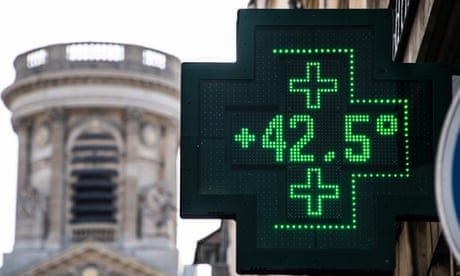Cloud seeding involves adding small particles of silver iodide to clouds to spur rainfall – but will it work?

An empty irrigation canal at a tree farm in Corrales, New Mexico. Forty percent of the US west of the continental divide classed as being in ‘exceptional drought’, the most severe of four levels of drought. Photograph: Susan Montoya Bryan/AP
Supported by
.png)
Oliver Milman
@olliemilman
Tue 23 Mar 2021
Supported by
.png)
Oliver Milman
@olliemilman
Tue 23 Mar 2021
THE GUARDIAN
With three-quarters of the US west gripped by a seemingly ceaseless drought, several states are increasingly embracing a drastic intervention – the modification of the weather to spur more rainfall.

Climate crisis: recent European droughts 'worst in 2,000 years'
The latest reports from the US Drought Monitor have provided sobering reading, with 40% of the US west of the continental divide classed as being in “exceptional drought”, the most severe of four levels of drought. This is down only marginally from 47% in January, a record in the monitor’s 20-year history, and barring the arrival of a barrage of late winter storms will almost guarantee a severely parched year for western states.
“We haven’t had much in the way of winter rain or snow, which is concerning, as we would hope to put a big dent in the drought,” said Brian Fuchs, a climatologist at the National Drought Mitigation Center. “It looks like it’s going to be a very tough year. We are probably looking at increased fire dangers, water restrictions and also impacts to ecosystems, such as small rivers and streams and the wildlife living there.”
The stresses of drought, upon water supplies for drinking and to supply the west’s vast agricultural systems, have prompted eight states to look to a form of weather modification called cloud seeding to stave off the worst.
Cloud seeding involves using aircraft or drones to add small particles of silver iodide, which have a structure similar to ice, to clouds. Water droplets cluster around the particles, modifying the structure of the clouds and increasing the chance of precipitation.
“With drought still a major concern, cloud seeding is an encouraged technology for Wyoming to use based on our drought contingency plan,” said Julie Gondzar, project manager for the state’s water development office. “It is an inexpensive way to help add water to our basins, in small, incremental amounts over long periods of time.”
Cloud seeding experiments have taken place since the 1940s but until recently there was little certainty the method had any positive impact. But research last year managed to pinpoint snowfall that “unambiguously” came from cloud seeding and Gondzar said officials in Wyoming and elsewhere have “concluded that cloud seeding works, and is an effective way to aid in drought-stricken areas, with no negative environmental impacts”.
Others are now looking to join in, including the “four corners” states – Utah, Arizona, Colorado and New Mexico – that have been ravaged by the most extreme version of the latest drought. “We are very hopeful for significant funding this year with an eye towards enough to do the entire state in the future,” said Rick Ledbetter, a supervisor for the Roosevelt soil and water district in New Mexico who has run a pilot scheme for cloud seeding. “I believe that there will be no choice in the future but to look at weather modification.”
Experts who have studied cloud seeding point out that it is no panacea, given it doesn’t solve the systemic causes of drought and can be tricky to implement – only certain clouds in certain weather conditions can be seeded with nascent rain and there’s no guarantee it will break a drought even if successful.
“I don’t think cloud seeding will solve the problem but it can help,” said Katja Friedrich, a University of Colorado researcher who has studied the issue. “It needs to be part of a broader water plan that involves conserving water efficiently, we can’t just focus on one thing. Also there is a question whether you will be able to do it in a changing climate – you need cold temperatures and once it gets too warm you aren’t able to do the cloud seeding.”
While states attempt to formulate a response to the growing threat of drought, advocates warn that poorer people, and people of color, are most likely to suffer from a water-constrained future. Miguel Hernandez, from the non-profit Comite Civico de Valle group in Imperial Valley, southern California, said the drought has brought ongoing issues for Latino agricultural workers, some of whom have to resort to using irrigation canals for cooking water or for brushing their teeth.
“Getting them good drinkable water is a priority,” he said. “We have issues with water diverted away to metropolitan areas too, leaving us with little to no water in our region. The drought causes a lot of different issues here.”
The current drought has been building since an exceptionally hot summer last year but the past 20 years can be seen collectively as a “mega-drought” in the US west, Fuchs said. Scientists have pointed to the climate crisis as a key cause.
“There has been very little relief and this could well be a precursor to what can be expected for the west in the future,” Fuchs said. “It’s kind of scary to think that way.”
No comments:
Post a Comment